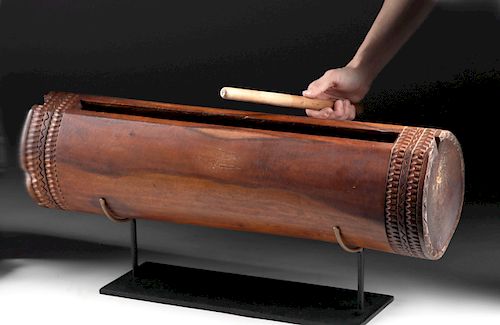Early 20th C. Marquesas Islands Ceremonial Wood Drum
Lot 167b
About Seller
Artemis Fine Arts
686 S Taylor Ave, Ste 106
Louisville, CO 80027
United States
Selling antiquities, ancient and ethnographic art online since 1993, Artemis Gallery specializes in Classical Antiquities (Egyptian, Greek, Roman, Near Eastern), Asian, Pre-Columbian, African / Tribal / Oceanographic art. Our extensive inventory includes pottery, stone, metal, wood, glass and textil...Read more
Estimate:
$2,800 - $4,000
Absentee vs Live bid
Two ways to bid:
- Leave a max absentee bid and the platform will bid on your behalf up to your maximum bid during the live auction.
- Bid live during the auction and your bids will be submitted real-time to the auctioneer.
Bid Increments
| Price | Bid Increment |
|---|---|
| $0 | $25 |
| $300 | $50 |
| $1,000 | $100 |
| $2,000 | $250 |
| $5,000 | $500 |
| $10,000 | $1,000 |
| $20,000 | $2,500 |
| $50,000 | $5,000 |
| $100,000 | $10,000 |
| $200,000 | $20,000 |
About Auction
By Artemis Fine Arts
May 23, 2019
Set Reminder
2019-05-23 10:00:00
2019-05-23 10:00:00
America/New_York
Bidsquare
Bidsquare : Exceptional Day 2 Ethnographic Tribal Fossils
https://www.bidsquare.com/auctions/artemis-gallery/exceptional-day-2-ethnographic-tribal-fossils-4136
Day 2 of an important 2-day auction featuring exceptional ethnographic art from around the world. Today's sale will feature Pre-Columbian from the ancient americas, Native American, African / Tribal, Oceanic, Spanish Colonial, and incredible Fossils. Artemis Fine Arts info@artemisfinearts.com
Day 2 of an important 2-day auction featuring exceptional ethnographic art from around the world. Today's sale will feature Pre-Columbian from the ancient americas, Native American, African / Tribal, Oceanic, Spanish Colonial, and incredible Fossils. Artemis Fine Arts info@artemisfinearts.com
- Lot Description
Oceania, Marquesas Islands (French Polynesia), ca. early 20th century CE. One of my favorites! A large, elegant wooden slit drum made for use in ceremonies. The body is a rich, red-brown hardwood, and the drum has been carved mainly from a single log, hollowed out through its center and with solid, round slices of trunk attached to either end. A long, thin, rectangular slit is open on the top side, which is denoted by a slight planing of the log surface to create a narrow flat space that encompasses the slit and gives it a border. Slits are also excised from the trunk slices at either end along the same line. Incised around the two horizontal ends of the drum are a series of repeated wave-like motifs. The slit drum, known elsewhere in Polynesia as a "pate", is called a "to'ere" amongst the Marquesans. Size: 27" W x 7.3" H (68.6 cm x 18.5 cm); 12.2" H (31 cm) on included custom stand.
Ancient Marquesans were great drummers, creating multiple forms of the instrument and knowing many different sounds they could elicit from them. Dordillon (1808-1888), the French missionary who recorded the Marquesan language, lists thirteen different terms specifically referring to the sound that drums make. They played the to'ere (slit drum) in conjunction with a bass drum and a shorter drum; in the valley of Pua Mau, they also used a snare drum. They used drums to call warriors to the battlefield and to celebrate festivals. Stories of a famous Marquesan drum player named Tame, who lived in the early to mid-20th century, describe him leading a blindfolded dancer through a routine using just his drumming.
Provenance: private Hawaii, USA collection; ex-private Maui, Hawaii, USA collection
All items legal to buy/sell under U.S. Statute covering cultural patrimony Code 2600, CHAPTER 14, and are guaranteed to be as described or your money back.
A Certificate of Authenticity will accompany all winning bids.
We ship worldwide and handle all shipping in-house for your convenience.
#146137Surface is weathered and worn, with tiny chips and nicks along its length. One end has a larger chip knocked out of its center, but this does not break through to the interior of the drum, which is still playable.Condition
- Shipping Info
-
All shipping is handled in-house for your convenience. Your invoice from Artemis Gallery will include shipping calculation instructions. If in doubt, please inquire BEFORE bidding for estimated shipping costs for individual items.
-
- Buyer's Premium



 EUR
EUR CAD
CAD AUD
AUD GBP
GBP MXN
MXN HKD
HKD CNY
CNY MYR
MYR SEK
SEK SGD
SGD CHF
CHF THB
THB














